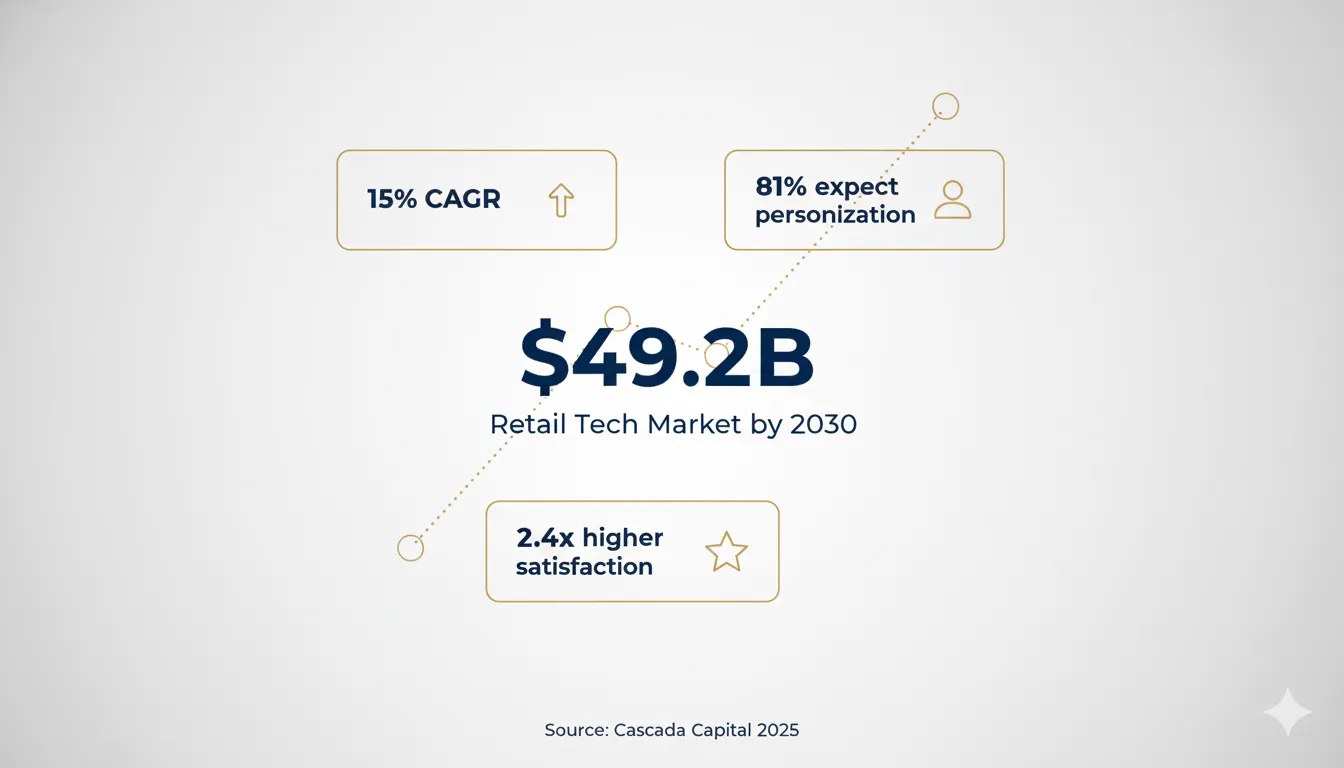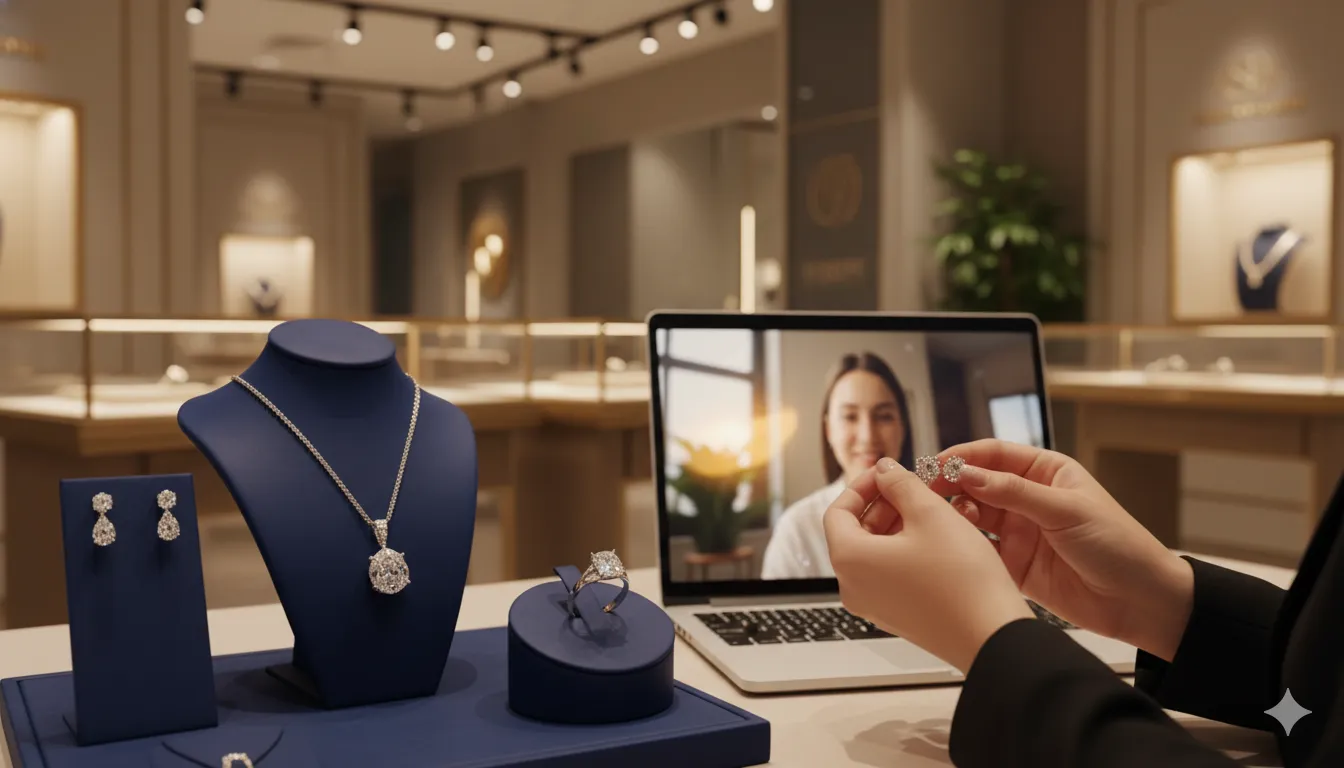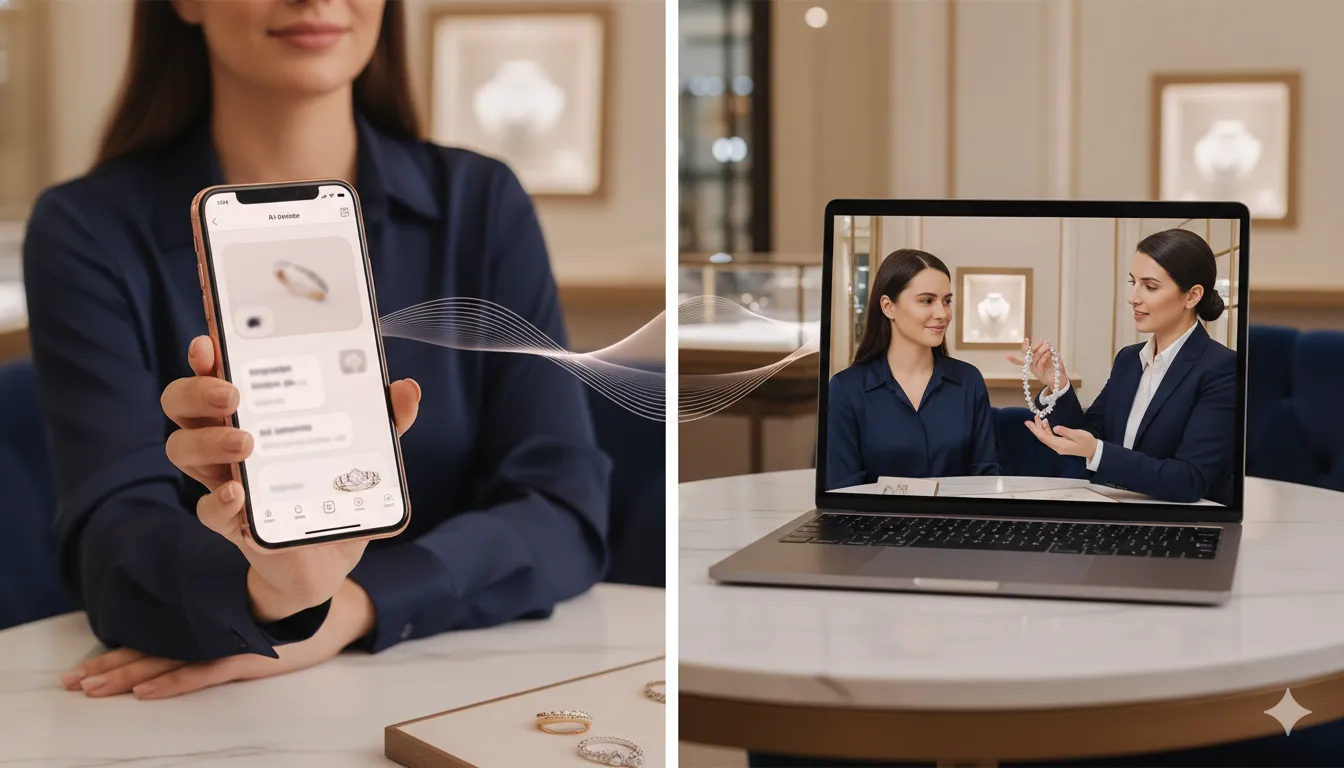5 Technologies Reshaping Luxury Retail in 2025 (And What They Mean for High-End Brands)
The luxury retail landscape is undergoing its most significant transformation in decades.
While digital transformation has been reshaping retail for years, luxury brands have traditionally resisted change—prioritizing exclusivity, in-person experiences, and carefully controlled brand narratives.
That’s changing. Fast.
According to Cascadia Capital’s 2025 Retail Technology Report, the Customer Experience Enhancement sector (which includes luxury retail technologies) is growing at 15.2% CAGR, outpacing nearly every other segment of retail tech.
The reason? Luxury consumers now expect personalization, convenience, and seamless experiences—without sacrificing the premium service that defines high-end shopping.
Here are the five technologies making this possible.
1. AI-Powered Clienteling Platforms: The Digital Sales Associate
The Challenge:
Luxury brands built their reputation on personalized, one-on-one service. But scaling that experience across locations, channels, and customer touchpoints has always been difficult.
The Solution:
AI-powered clienteling platforms give sales associates instant access to comprehensive customer profiles, purchase history, preferences, and predictive recommendations—all in real-time.
How It Works:
Platforms like Tulip, Endear, and Salesfloor integrate with your existing systems (POS, CRM, inventory management) to create a unified view of each customer.
When a VIP client walks into a store:
- The associate receives an alert on their tablet
- They see the customer’s entire purchase history
- AI suggests products based on past preferences
- They can check inventory across all locations instantly
- They can reserve items, arrange alterations, or schedule follow-ups—all without leaving the floor
Real-World Impact:
Dolce & Gabbana, Versace, and Michael Kors have all adopted clienteling platforms in the last 18 months.
The results speak for themselves:
- Engaged shoppers spend 2x more than non-engaged customers
- Sales associates report 50% higher close rates when using clienteling tools
- Customer lifetime value increases by 30-40% for clients with dedicated associate relationships
Key Insight for Luxury Brands:
Clienteling platforms don’t replace human relationships—they amplify them. The best sales associates were always great at remembering preferences and anticipating needs. Now, every associate can provide that level of service.
2. Live Commerce: Bringing the Showroom Experience Online
The Challenge:
High-end products require touch, feel, and expert guidance. Ecommerce has always felt inadequate for luxury goods—static images can’t convey craftsmanship, and checkout pages lack the romance of an in-store experience.
The Solution:
Live shopping events combine video content, real-time interaction, and seamless checkout into a single, immersive experience.
How It Works:
Luxury brands host live events featuring:
- Product demonstrations by experts or brand ambassadors
- Q&A sessions with designers or artisans
- Exclusive launches or limited-edition releases
- Real-time purchasing without leaving the stream
Platforms like Immerss specialize in creating high-end live shopping experiences that maintain brand prestige while enabling instant transactions.
Why It’s Working for Luxury:
Unlike mass-market live shopping (think QVC), luxury live commerce emphasizes:
- Storytelling – Highlighting craftsmanship, heritage, and design philosophy
- Exclusivity – Limited-time access, VIP-only events, or invitation-based streams
- Curation – Fewer products, more depth and context
Real-World Impact:
According to the Cascadia report, social commerce is projected to reach $137B by 2028 in the US alone, with luxury brands increasingly testing the channel.
Early adopters report:
- 15-25% conversion rates during live events (compared to 2-3% for standard ecommerce)
- Higher average order values ($300-500 vs. $150-200 on traditional ecommerce)
- Stronger emotional connection with brand and product
Key Insight for Luxury Brands:
Live commerce works when it feels like an event, not a transaction. The brands winning in this space treat live shopping like a product launch, fashion show, or trunk show—not a sales pitch.
3. Sentiment Analysis & Emotion-Aware AI: Reading Between the Lines
The Challenge:
Understanding customer satisfaction traditionally required surveys, focus groups, or post-purchase feedback—all of which come too late to fix issues in real-time.
The Solution:
AI-powered sentiment analysis processes customer interactions in real-time, detecting emotions like frustration, excitement, or confusion—and alerting teams to respond immediately.
How It Works:
Modern sentiment analysis goes far beyond keyword detection. It uses:
- Natural language processing (NLP) to understand context and tone
- Behavioral signals (mouse movement, page dwell time, scroll patterns)
- Voice analysis (in call centers or virtual shopping sessions)
- Facial recognition (in physical stores, where permitted)
The system can:
- Identify when a customer is struggling with checkout → trigger live chat support
- Detect frustration in a customer service call → escalate to a specialist
- Notice a VIP browsing high-value items → alert a sales associate
Real-World Impact:
According to Cascadia’s research:
- Companies using real-time sentiment analysis are 2.4x more likely to exceed customer satisfaction goals
- AI-powered systems can analyze up to 245,000 interactions per second
- Sam’s Club reduced checkout times by 23% using sentiment analysis to identify friction points
For luxury brands, this means:
- Catching service failures before they escalate
- Proactively delighting high-value customers
- Personalizing experiences based on emotional state, not just purchase history
Key Insight for Luxury Brands:
Sentiment analysis is most powerful when it informs human action, not replaces it. Use AI to identify moments that matter, then empower your team to respond with personalized care.
4. Omnichannel Inventory & Fulfillment: The End of “Out of Stock”
The Challenge:
Luxury customers expect products to be available when and where they want them—whether in-store, online, or for same-day delivery. But managing inventory across channels has traditionally been a nightmare.
The Solution:
Real-time inventory visibility combined with flexible fulfillment options creates a seamless experience no matter where a customer shops.
How It Works:
Advanced inventory systems integrate:
- Point-of-sale (POS) systems in physical stores
- eCommerce platforms
- Warehouse management systems (WMS)
- Third-party marketplaces (if applicable)
Customers can:
- Check in-store availability online before visiting
- Order online and pick up in-store (BOPIS)
- Ship from any location (store, warehouse, or another retail location)
- Return online purchases in-store (or vice versa)
Real-World Impact:
According to the report:
- 88% of shoppers expect consistent experiences across online, mobile, and in-store
- 55% of consumers value in-person shopping even when they purchase online
- Curbside pickup sales expected to reach $154B in 2025 in the US
For luxury brands specifically:
- 73% of shoppers use multiple channels before making a purchase
- Brands with strong omnichannel strategies see 30% higher lifetime customer value
Key Insight for Luxury Brands:
Omnichannel isn’t about making every channel identical—it’s about making transitions between channels seamless. A customer should be able to start shopping on Instagram, continue on your website, and complete the purchase in-store without friction.
5. Personalization Engines: From Segments to Individuals
The Challenge:
Traditional marketing relies on segmentation—grouping customers into categories (age, income, location) and treating everyone in that segment the same way.
But luxury shoppers don’t want to be treated like a segment. They want to be treated like individuals.
The Solution:
AI-driven personalization engines analyze individual behavior, preferences, and context to deliver unique experiences to every customer.
How It Works:
Modern personalization engines use machine learning to:
- Analyze browsing and purchase history
- Identify patterns and preferences
- Predict what a customer is likely to want next
- Tailor content, recommendations, and offers in real-time
This works across:
- Product recommendations – Showing items that match individual style, not just “what’s popular”
- Content personalization – Displaying editorial content, lookbooks, or videos based on interests
- Email marketing – Sending messages at optimal times with relevant products
- Dynamic pricing – Offering VIP-exclusive pricing or early access to loyal customers
Real-World Impact:
According to the report:
- 81% of consumers prefer companies that provide personalized experiences
- Retailers using AI-driven personalization see 10-15% increases in revenue
- 73% of shoppers expect retailers to understand their preferences
Luxury examples:
- Sephora’s Color IQ uses AI to match products to individual skin tones
- Nike By You lets customers design products guided by ML-driven recommendations
- L’Oréal uses AI to analyze feedback and return patterns, helping brands optimize sizing and recommendations
Key Insight for Luxury Brands:
Personalization at scale requires both technology and taste. The best luxury brands use AI to power recommendations, but maintain human curation to ensure every suggestion aligns with brand aesthetic.
Bringing It All Together: The Future of Luxury Retail
These five technologies aren’t isolated tools—they’re interconnected pieces of a larger transformation.
The luxury brands winning in 2025 are those that:
✅ Use clienteling platforms to empower their sales teams ✅ Experiment with live commerce to create exclusive, engaging shopping moments ✅ Deploy sentiment analysis to catch and resolve issues in real-time ✅ Invest in omnichannel infrastructure to meet customers wherever they are ✅ Leverage personalization engines to treat every customer as an individual
But here’s the critical part:
Technology alone isn’t enough.
Luxury retail has always been about human connection, craftsmanship, and storytelling. The brands that succeed are those that use technology to enhance these qualities—not replace them.
What This Means for Your Brand
If you’re leading digital transformation at a luxury brand, here are the key questions to ask:
1. Are we empowering our sales associates—or working around them?
The best technology makes your team more effective, not redundant.
2. Does our digital experience match our in-store experience?
If your eCommerce feels transactional while your stores feel luxurious, you have a brand consistency problem.
3. Are we personalizing at the individual level—or still segmenting?
“Women 25-45 with high income” is not personalization. Recommendations based on browsing behavior, style preferences, and past purchases are.
4. Can we deliver on the promises we make?
Omnichannel only works if your backend can support it. Don’t promise same-day delivery if your inventory systems can’t track it.
5. Are we experimenting with new channels—or waiting for proof?
Live commerce, social shopping, and creator partnerships are still emerging. Early movers have an advantage.
Ready to Transform Your Customer Experience?
At Immerss, we specialize in helping luxury brands create live shopping experiences that maintain exclusivity, elevate storytelling, and drive meaningful engagement.
If you’re exploring how live commerce, personalization, or omnichannel strategies can work for your brand, we’d love to connect.
Schedule a Demo | Learn More About Live Commerce
Key Takeaways:
✅ Customer Experience tech in luxury retail growing 15%+ annually ✅ Clienteling platforms helping brands scale personalized service ✅ Live commerce delivering 15-25% conversion rates for luxury brands ✅ Sentiment analysis enabling real-time issue resolution ✅ Omnichannel infrastructure now expected by 88% of shoppers ✅ AI-driven personalization increasing revenue by 10-15%



